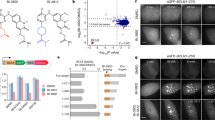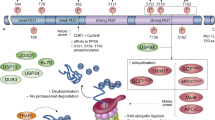Abstract
CrkL is a key signaling protein that mediates the leukemogenic activity of Bcr-Abl. CrkL is thought to adopt a structure that is similar to that of its CrkII homolog. The two proteins share high sequence identity and indistinguishable ligand binding preferences, yet they have distinct physiological roles. Here we show that the structures of CrkL and phosphorylated CrkL are markedly different than the corresponding structures of CrkII. As a result, the binding activities of the Src homology 2 and Src homology 3 domains in the two proteins are regulated in a distinct manner and to a different extent. The different structural architecture of CrkL and CrkII may account for their distinct functional roles. The data show that CrkL forms a constitutive complex with Abl, thus explaining the strong preference of Bcr-Abl for CrkL. The results also highlight how the structural organization of the modular domains in adaptor proteins can control signaling outcome.
This is a preview of subscription content, access via your institution
Access options
Subscribe to this journal
Receive 12 print issues and online access
$259.00 per year
only $21.58 per issue
Buy this article
- Purchase on Springer Link
- Instant access to full article PDF
Prices may be subject to local taxes which are calculated during checkout





Similar content being viewed by others
References
Birge, R.B., Kalodimos, C., Inagaki, F. & Tanaka, S. Crk and CrkL adaptor proteins: networks for physiological and pathological signaling. Cell Commun. Signal. 7, 13 (2009).
Isakov, N. A new twist to adaptor proteins contributes to regulation of lymphocyte cell signaling. Trends Immunol. 29, 388–396 (2008).
Cabodi, S., del Pilar Camacho-Leal, M., Di Stefano, P. & Defilippi, P. Integrin signalling adaptors: not only figurants in the cancer story. Nat. Rev. Cancer 10, 858–870 (2010).
Kim, Y.H. et al. Genomic and functional analysis identifies CRKL as an oncogene amplified in lung cancer. Oncogene 29, 1421–1430 (2010).
Mintz, P.J. et al. An unrecognized extracellular function for an intracellular adapter protein released from the cytoplasm into the tumor microenvironment. Proc. Natl. Acad. Sci. USA 106, 2182–2187 (2009).
Wang, H. et al. The role of Crk/Dock180/Rac1 pathway in the malignant behavior of human ovarian cancer cell SKOV3. Tumour Biol. 31, 59–67 (2010).
Feng, R. et al. miR-126 functions as a tumour suppressor in human gastric cancer. Cancer Lett. 298, 50–63 (2010).
Noren, N.K., Foos, G., Hauser, C.A. & Pasquale, E.B. The EphB4 receptor suppresses breast cancer cell tumorigenicity through an Abl-Crk pathway. Nat. Cell Biol. 8, 815–825 (2006).
Matsuda, M. et al. Two species of human CRK cDNA encode proteins with distinct biological activities. Mol. Cell. Biol. 12, 3482–3489 (1992).
ten Hoeve, J., Morris, C., Heisterkamp, N. & Groffen, J. Isolation and chromosomal localization of CRKL, a human crk-like gene. Oncogene 8, 2469–2474 (1993).
Feller, S.M., Knudsen, B. & Hanafusa, H. c-Abl kinase regulates the protein binding activity of c-Crk. EMBO J. 13, 2341–2351 (1994).
de Jong, R., ten Hoeve, J., Heisterkamp, N. & Groffen, J. Tyrosine 207 in CRKL is the BCR/ABL phosphorylation site. Oncogene 14, 507–513 (1997).
Songyang, Z. et al. SH2 domains recognize specific phosphopeptide sequences. Cell 72, 767–778 (1993).
Wu, X. et al. Structural basis for the specific interaction of lysine-containing proline-rich peptides with the N-terminal SH3 domain of c-Crk. Structure 3, 215–226 (1995).
Cheerathodi, M. & Ballif, B.A. Identification of CrkL-SH3 binding proteins from embryonic murine brain: implications for reelin signaling during brain development. J. Proteome Res. 10, 4453–4462 (2011).
Muralidharan, V. et al. Solution structure and folding characteristics of the C-terminal SH3 domain of c-Crk-II. Biochemistry 45, 8874–8884 (2006).
Sarkar, P., Reichman, C., Saleh, T., Birge, R.B. & Kalodimos, C.G. Proline cis-trans isomerization controls autoinhibition of a signaling protein. Mol. Cell 25, 413–426 (2007).
Sarkar, P., Saleh, T., Tzeng, S.-R., Birge, R.B. & Kalodimos, C.G. Structural basis for regulation of the Crk signaling protein by a proline switch. Nat. Chem. Biol. 7, 51–57 (2011).
Kobashigawa, Y. et al. Structural basis for the transforming activity of human cancer-related signaling adaptor protein CRK. Nat. Struct. Mol. Biol. 14, 503–510 (2007).
Antoku, S. & Mayer, B.J. Distinct roles for Crk adaptor isoforms in actin reorganization induced by extracellular signals. J. Cell Sci. 122, 4228–4238 (2009).
Senechal, K., Halpern, J. & Sawyers, C. The CRKL adaptor protein transforms fibroblasts and functions in transformation by the BCR-ABL oncogene. J. Biol. Chem. 271, 23255–23261 (1996).
Sattler, M. & Salgia, R. Role of the adapter protein CRKL in signal transduction of normal hematopoietic and BCR/ABL-transformed cells. Leukemia 12, 637–644 (1998).
Colicelli, J. ABL tyrosine kinases: evolution of function, regulation, and specificity. Sci. Signal. 3, re6 (2010).
Seo, J.H. et al. A specific need for CRKL in p210BCR-ABL–induced transformation of mouse hematopoietic progenitors. Cancer Res. 70, 7325–7335 (2010).
Luo, B. et al. Highly parallel identification of essential genes in cancer cells. Proc. Natl. Acad. Sci. USA 105, 20380–20385 (2008).
Nichols, G.L. et al. Identification of CRKL as the constitutively phosphorylated 39-kD tyrosine phosphoprotein in chronic myelogenous leukemia cells. Blood 84, 2912–2918 (1994).
ten Hoeve, J., Arlinghaus, R.B., Guo, J.Q., Heisterkamp, N. & Groffen, J. Tyrosine phosphorylation of CRKL in Philadelphia+ leukemia. Blood 84, 1731–1736 (1994).
Lucas, C.M. et al. BCR-ABL1 tyrosine kinase activity at diagnosis, as determined via the pCrkL/CrkL ratio, is predictive of clinical outcome in chronic myeloid leukaemia. Br. J. Haematol. 149, 458–460 (2010).
Guris, D.L., Fantes, J., Tara, D., Druker, B.J. & Imamoto, A. Mice lacking the homologue of the human 22q11.2 gene CRKL phenocopy neurocristopathies of DiGeorge syndrome. Nat. Genet. 27, 293–298 (2001).
Wang, J. et al. Crk and CrkL present with different expression and significance in epithelial ovarian carcinoma. Mol. Carcinog. 50, 506–515 (2011).
Mihrshahi, R. & Brown, M.H. Downstream of tyrosine kinase 1 and 2 play opposing roles in CD200 receptor signaling. J. Immunol. 185, 7216–7222 (2010).
Donaldson, L.W., Gish, G., Pawson, T., Kay, L.E. & Forman-Kay, J.D. Structure of a regulatory complex involving the Abl SH3 domain, the Crk SH2 domain, and a Crk-derived phosphopeptide. Proc. Natl. Acad. Sci. USA 99, 14053–14058 (2002).
Harkiolaki, M., Gilbert, R.J.C., Jones, E.Y. & Feller, S.M. The C-terminal SH3 domain of CRKL as a dynamic dimerization module transiently exposing a nuclear export signal. Structure 14, 1741–1753 (2006).
Mittermaier, A.K. & Kay, L.E. Observing biological dynamics at atomic resolution using NMR. Trends Biochem. Sci. 34, 601–611 (2009).
Tjandra, N., Feller, S., Pastor, R. & Bax, A. Rotational diffusion anisotropy of human ubiquitin from N-15 NMR relaxation. J. Am. Chem. Soc. 117, 12562–12566 (1995).
Seo, J.-H., Suenaga, A., Hatakeyama, M., Taiji, M. & Imamoto, A. Structural and functional basis of a role for CRKL in a fibroblast growth factor 8–induced feed-forward loop. Mol. Cell. Biol. 29, 3076–3087 (2009).
Cho, J.-H. et al. Tuning protein autoinhibition by domain destabilization. Nat. Struct. Mol. Biol. 18, 550–555 (2011).
Senechal, K., Heaney, C., Druker, B. & Sawyers, C. Structural requirements for function of the Crkl adapter protein in fibroblasts and hematopoietic cells. Mol. Cell. Biol. 18, 5082–5090 (1998).
Rosen, M.K. et al. Direct demonstration of an intramolecular SH2-phosphotyrosine interaction in the Crk protein. Nature 374, 477–479 (1995).
Ren, R., Ye, Z.S. & Baltimore, D. Abl protein-tyrosine kinase selects the Crk adapter as a substrate using SH3-binding sites. Genes Dev. 8, 783–795 (1994).
Huang, X., Wu, D., Jin, H., Stupack, D. & Wang, J.Y.J. Induction of cell retraction by the combined actions of Abl-CrkII and Rho-ROCK1 signaling. J. Cell Biol. 183, 711–723 (2008).
Pawson, T. Dynamic control of signaling by modular adaptor proteins. Curr. Opin. Cell Biol. 19, 112–116 (2007).
Sawada, Y. et al. Force sensing by mechanical extension of the Src family kinase substrate p130Cas. Cell 127, 1015–1026 (2006).
Kardinal, C. et al. Cell-penetrating SH3 domain blocker peptides inhibit proliferation of primary blast cells from CML patients. FASEB J. 14, 1529–1538 (2000).
Sriram, G. et al. Phosphorylation of Crk on tyrosine 251 in the RT loop of the SH3C domain promotes Abl kinase transactivation. Oncogene 30, 4645–4655 (2011).
Li, S.S. Specificity and versatility of SH3 and other proline-recognition domains: structural basis and implications for cellular signal transduction. Biochem. J. 390, 641–653 (2005).
Severin, A., Joseph, R.E., Boyken, S., Fulton, D.B. & Andreotti, A.H. Proline isomerization preorganizes the Itk SH2 domain for binding to the Itk SH3 domain. J. Mol. Biol. 387, 726–743 (2009).
Chan, B. et al. SAP couples Fyn to SLAM immune receptors. Nat. Cell Biol. 5, 155–160 (2003).
Rückert, M. & Otting, G. Alignment of biological macromolecules in novel nonionic liquid crystalline media for NMR experiments. J. Am. Chem. Soc. 122, 7793–7797 (2000).
Shen, Y., Delaglio, F., Cornilescu, G. & Bax, A. TALOS+: a hybrid method for predicting protein backbone torsion angles from NMR chemical shifts. J. Biomol. NMR 44, 213–223 (2009).
Acknowledgements
We thank S. Karamanou for performing the MALLS experiments and D. Duffield for collecting the mass spectrometry data. This work was supported by the US Department of Defense (R.B.B.) and the US National Institutes of Health (GM80308 to C.G.K.).
Author information
Authors and Affiliations
Contributions
W.J., T.S., G.S., R.B.B. and C.G.K. designed research; W.J., T.S., M.-T.P. and G.S. performed research; W.J., T.S., M.-T.P., G.S., R.B.B. and C.G.K. analyzed data; W.J., T.S. and C.G.K. wrote the manuscript.
Corresponding author
Ethics declarations
Competing interests
The authors declare no competing financial interests.
Supplementary information
Supplementary Text and Figures
Supplementary Methods and Supplementary Results (PDF 3699 kb)
Rights and permissions
About this article
Cite this article
Jankowski, W., Saleh, T., Pai, MT. et al. Domain organization differences explain Bcr-Abl's preference for CrkL over CrkII. Nat Chem Biol 8, 590–596 (2012). https://doi.org/10.1038/nchembio.954
Received:
Accepted:
Published:
Issue Date:
DOI: https://doi.org/10.1038/nchembio.954
This article is cited by
-
Crk proteins activate the Rap1 guanine nucleotide exchange factor C3G by segregated adaptor-dependent and -independent mechanisms
Cell Communication and Signaling (2023)
-
Atomic view of the energy landscape in the allosteric regulation of Abl kinase
Nature Structural & Molecular Biology (2017)
-
The chimeric ubiquitin ligase SH2-U-box inhibits the growth of imatinib-sensitive and resistant CML by targeting the native and T315I-mutant BCR-ABL
Scientific Reports (2016)
-
A pre-metazoan origin of the CRK gene family and co-opted signaling network
Scientific Reports (2016)
-
Cyclophilin A promotes cell migration via the Abl-Crk signaling pathway
Nature Chemical Biology (2016)



